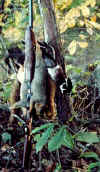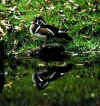|
Copyright ©
2004 by Bill Scifres
October (written
in 2004)
As summer wanes outdoor recreation opportunities
are amplified, but hunting still draws great numbers of Hoosiers into the
wild. One of the most interesting hunts will be found on small streams
and creeks where the wood duck is king.
Oh, Yes! The deer season opens for bowhunters October
1. It extends, with a short hiatus in December, into January. And
this translates into a great combination hunt--deer at daylight and at
dusk, and jump-shooting woodies through the middle of the day.
In my book, October is the month of the wood
duck (Aix sponsa) for two simple reasons. First, the wood duck probably
produces more young in Indiana than any other species of waterfowl. As
a matter of fact, for many years in the pre-MM (municipal mallard) years,
the wood duck was the only important producer of wild ducks in Indiana.
Secondly, the wood duck is as much at home in other Midwestern states as
it is in Indiana, and the species is known for its aversion to cold weather.
Thus, when nights grow cold--like late in September
and early in October--wood ducks start congregating on small streams and
creeks in preparation for their migration to warmer climes.
This creates ideal conditions for jump-shooting
woodies on small streams and creeks, but for many years the little black
squealers (as I knew them as a boy) had temporarily changed their address
early and were not available to Hoosier hunters in good numbers when our
waterfowl seasons opened. In those years federal regulations did not allow
states to opt for split seasons. As a result, the bulk of wood ducks, many
of which were hatched in Indiana, were long gone before waterfowl seasons
opened.
When federal regulations offered split season
options in the late 1960s, the woodie took its place as one of the most
harvested ducks in Hoosierland’s total waterfowl bag. There are, of course
a pair of simple reasons for this. First, the wood duck is characteristically
a small stream duck that is a real test of one’s outdoors skills. Secondly,
the woody’s preference for grain (especially corn and soybeans) makes the
species one of the tastiest waterfowl on the table.
Wood ducks can be hunted with success on standing
waters during the day (with or without decoys), or at roosting spots as
they go to bed with the sinking sun. But the mid-day bank stalking is a
game of its own, and it combines well with squirrel hunting while keeping
one’s eyes open for many other products, both real (as in fall mushrooms),
and aesthetic (as in wildflowers and fall colors).
Once a friend and I approached a creek bend in
northwestern Jackson County cautiously, knowing there were woodies there
because we could hear their squeals.
We rattled off several shots when the birds flushed.
But when our eyes met through the brush, we gave each other the “thumbs-down”
sign. We both had missed. We knew we had missed cleanly and as we shared
our lack of success in whispers as I fished a bread sack from the pocket
of my hunting coat and headed for the edge of the water.
”I thought you said you didn’t get any,”
my friend said.
Smiling, as I walked to the water’s edge, I said:
“I missed the ducks because I was so excited about seeing hickory jacks
(mushrooms) on that log at the edge of the water. I’m going to get my reward.”
And so I did.
There would be plenty of time--on other bends
in the creek--to bag a limit of two woodies. And those hickory jacks would
give their special blend of goodness to the roast wood duck dinner the
next day.
The whys and wherefores of jump-shooting wood
duck on small streams and creeks will come to those who understand the
habits of the species. I could write a book about the characteristics of
this beautiful bird, but a hunter who wants to understand this bird will
learn more in a fe days on a stream than any writer could give him.
Wood ducks prefer streams and creeks (no matter
how small) because such waters usually are lined with yet another pair
of conditions. First, small streams and creeks--even drainage ditches of
some size--most often are lined with trees large enough to offer hollow
trunks and large limbs. Woodies nest there. Secondly, such waters often
are adjacent to crop lands. In Indiana that translates into field corn
and soybeans, two of the wood duck’s favorite foods.
The cavities in trees offer nest sites for wood
ducks. If they are hatched on such waters, it is little wonder that they
will spend a good part of their time there.
But the importance of adjacent croplands--harvested
or standing--is an important element of the formula for favorite haunts
of woodies in the fall. I have seen crop rotations change the allure of
given stretches of streams from one year to the next.
Mast--acorns and other seeds of trees--can’t
be ignored when jump-shooting woodies. Pin oak, red oak and white oak acorns
are important sources of food for woodies, but I have found this species
feeding on the seeds of many other plants, shrubs and trees. A check of
wood duck crops (a storage area where foods are held before they are digested)
will reveal many sources of food.
I learned about the value of acorns as a source
of food for woodies many years ago on a bank-stalking hunt on one of the
old beds of the Muscatatuck River. I came to a place where a smaller drainage
ditch (only six or eight feet wide) entered the old riverbed, and I faced
a decision. If I wanted to follow the old bed of the river, I would have
to cross the smaller ditch which translated into removing my knee-high
boots to avoid getting them filled with water. I had never found woodies
on the ditch so I elected to wade it and follow the old bed of the river.
The old bed of the river ended a quarter of a
mile or so upstream, which translated into another decision. I could retrace
my steps back to the confluence of the drainage ditch and the old riverbed,
or I could cut across a weed field and hit the drainage ditch near a road
and a farmhouse. Out of curiosity, I chose the latter.
At the point where the drainage ditch bisected
the small wooded area I let my best stalking efforts slide a bit. I had
checked the water of the ditch upstream without seeing any sign of ducks.
It was easy to become more interested in squirrels while moving as quietly
as possible through the woods.
I could see significant limb movement in a big
red oak tree 50 yards or more from the banks of the ditch. That whetted
my interest in squirrels, and I employed my best woodland stalking tactics
while searching every limb of the tree for the squirrel.
As I approached the oak--still very much in a
squirrel-hunting mode--the forest floor exploded as 20 to 30 woodies took
to flight in an air-thrashing roar that left me standing with shotgun in
the crook of my arm.
An inspection of the forest floor under the oak
revealed a bumper crop of acorns, and strong evidence that the acorns were
a major source of food for the woodies that were using the old riverbed.
I would find the flock of woodies again
in a big bend of the old riverbed, and this time I would bag my limit of
two ducks. And interestingly enough, their crops would be full of red oak
acorns.
Aside from a tight-shooting shotgun and powerful
loads of No. 1 or BB steel shot, bank-stalking woodies requires comfortable
clothing, and a lot of patience. In wet weather I like knee-length rubber
boots, but October often is dry and light shoes are suitable. Blaze orange
is advisable as a safety factor, but it is not required for waterfowl hunting
any time, and for squirrel hunting only from November 5 this year (2004)
through January 28 next year (2005).
Small, but high-quality binoculars are almost
as important as a good shotgun in jump-shooting woodies for the simple
reason that the hunter must stay away from the water if he/she hopes to
get within shooting range of ducks. A rule of thumb of most good jump shooters
is that if the hunter can see the water, ducks on the water can see the
hunter. They will most often flush long before the hunter is in range.
I believe bank-stalking woodies requires more stealth than stalking gray
squirrels.
I stay far enough away from stream banks that
I can’t see the water. I move slowly, making as little noise as possible.
Occasionally, I sneak (crawling if necessary) to a point where I can glass
the water ahead through a cover of weeds or brush.
Disturbances on the surface of the water will
alert me to the presence of ducks. When I see signs of ducks--or even the
ducks--I mark the spot by noting the location of trees. Then I make a wide
circle coming into the ducks--the final yards in a crouch or crawling.
Although movement on the surface of water are
a good sign that ducks are present, other critters of the wild _namely
muskrats and fish--can raise false hopes. It also is important to remember
that the wood duck often lives up to its name by perching on driftwood,
logs above the water, or resting at water’s edge on stream banks.
For these reasons, not every stalk pays off with
shots at ducks. But any time I see good woody cover, I check it out.
Although jump shooting woodies on small streams
is a high-quality outdoor experience, residuals add much to this activity.
The wood duck is one of the best ducks on the table, and the hunter who
studies the species will reap many benefits.
I have hunted woodies on many small streams and
old river beds in Southern Indiana, but one of the highlights of all of
these hunts came with my shotgun in the car as darkness settled over a
willow swamp of three or four acres.
I almost always had my limit of two woodies by
mid-afternoon, but I would linger in the area until shooting time ended
at sunset.
I would drive to the swamp, pull on my hip boots
or waders, and slip through the shallow water to take a seat on a moss-covered
log. As the day bowed out, wood ducks that used the creek by day would
descend on the swamp to roost--ladder walking down through the willows,
often hitting the water so close that I was splashed.
It was a fitting way to end a day.
Click on thumbnail
photo to see enlarged image.

|

|
My
Remington 1100 shotgun poses with a brace of squirrels and a
male
wood duck on an old bed of the Muscuatatuck River in Jackson County. |
The
wood duck is one of our most beautiful ducks and one on the
tastiest. |
|
|

|
|

